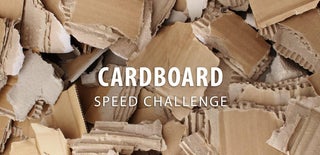Introduction: Re-purpose a Wine Delivery Box
We get wine delivered in strong cardboard boxes with a set of dividers, they look like they would make great kitchen storage boxes with twelve compartments for rolls of foil, silicon paper, and other stuff that is otherwise just piled on a shelf. Turning the box on its side will allow easy access to the contents but the dividers do need a bit of help to hold heavy rolls. Of course, you can use it in the craft room, workshop or anywhere else.
Supplies
I used
- A wine delivery box
- PLA 3D printer filament
- Super glue (sadly it didn't all fit together as neatly as I had hoped)
Tools
- A 3D Printer (Creality Ender 3 Pro)
- With a Raspberry Pi running Octoprint
- A measure
- (I used a digital caliper because I have one, a ruler would do just as well!)
Sotware
Step 1: The Problem
Although the box and dividers are good strong corrugated cardboard sheets, the box is designed for wine bottles; when placed on its side the dividers have no support.
I decided to design and make some pieces to stabilise the junctions and some braces to keep them in place.
Step 2: Junction Stabiliser
First I measured the thickness of the dividing walls and the size of the holes. I checked this by measuring the internal dimensions of the box and checking that four holes and three dividers added up to the long dimension and three holes and two dividers added up to the short dimension. With these details I could start designing the stabiliser parts:
The basic stabiliser needs to hold the four pieces of card that meet at the junction:
- I used FreeCAD to draw a 35mm dia circle and "pad" it to make a 3mm thick disk.
- I added an L shaped sketch to the disk with 10mm long legs and half round ends. This was placed half the thickness of the dividers (minus 0.1mm to make a snug fit) from the center in both x and y directions.
- The dividers were 6mm thick so this distance is (6/2 - 0.1 =) 2.9mm.
- This L piece was padded 20mm and the "polar pattern" tool used to make the required four supports.
Step 3:
- I added a 2.5mm thick 5mm square block to the L pieces 5mm from the disc to hold the braces in place.
- The polar pattern tool was used to copy this block to all the supports.
- This part was saved in FreeCAD for future use and also exported as an stl file.
- The stl file was imported into Cura and sliced with my standard PLA parameters.
- The resulting gcode was saved then imported into OctoPrint.
- A test print was made and fitted to the wine box.
Step 4: Edges and Corners
- The support part was opened in FreeCAD and trimmed to make the parts needed for the edges and corners.
- These were saved to separate files and exported as before to make test prints.
Step 5: Braces
- The braces were designed with 45 deg miters to vertical and horizontal bracing.
- The length was calculated as the length of the compartments minus twice the thickness of the L piece walls.
Step 6: Printing
- The box needs six four-way pieces, 10 edge pieces and four corner pieces.
- All the stabilising parts were printed in a single print.
Note: ·
Printing the multi piece version was slightly tricky with my Creality Ender 3-pro. A web search for similar problems suggested reducing the Retraction Distance; the default of 6.5mm was reduced to 3mm and the problem was fixed.
Step 7:
- And lots of braces
You will not need to brace both sides of each divider; trial and retrial are the best way to decide how many braces to use.
Step 8: Assembly
- It's fairly obvious where all the bits go.
Put the main "four-way" stabilisers on the joints first, then add some braces and the edge pieces.
The corner pieces have to be held in with braces. - I tried to only have one vertical brace for each vertical divider and to only have horizontal braces below the dividers, apart from the bottom row.
- The fit is not perfect so the best stability is obtained by putting a drop of "super glue" on one of the 45 deg faces of some of the braces where they are loose. Experiment to find the best compromise!
Step 9: Bonus!
The holes are just the right size to use Pringles tubes as containers. So I need to buy and eat lots of Pringles!
Step 10: Going Forward
I never seem to consider any project FINISHED!
I would like to improve the bracing and move it to in front of the dividers.
I would like not to have to use any glue!

Participated in the
Cardboard Speed Challenge












